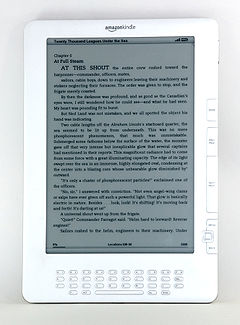Samsung's Orion 1GHz dual-core ARM Cortex-A9 mobile processor announced
Even if Samsung Fascinate didn't surprised us with its codename, maybe Samsung's announcement of mobile processor Orion will do the trick. So what are the surprises of the newly debuted dual-core Orion, "5 times the 3D graphics performance over the previous processor generation from Samsung, 1080p video encoding and decoding at 30fps, embedded GPS, a native triple display controller, and on-chip HDMI 1.3a interface." Still wants some more, read on after the break.
Orion's mass production is set first half of 2011, yet availability on "selected customers" at the end of this year. Meanwhile, if Hummingbird impressed us, we can't wait for this new processor to be fitted in a new powerful device.
TAIPEI, Taiwan--(BUSINESS WIRE)--Samsung Electronics Co., Ltd., a world leader in advanced semiconductor solutions, today introduced its new 1GHz ARM® CORTEXTM A9-based dual-core application processor, codenamed Orion, for advanced mobile applications. Device OEM developers now have a powerful dual processor chip platform designed specifically to meet the needs of high-performance, low-power mobile applications including tablets, netbooks and smartphones. Samsung's new processor will be demonstrated at the seventh annual Samsung Mobile Solutions Forum held here in Taiwan at the Westin Taipei Hotel.
TAIPEI, Taiwan--(BUSINESS WIRE)--Samsung Electronics Co., Ltd., a world leader in advanced semiconductor solutions, today introduced its new 1GHz ARM® CORTEXTM A9-based dual-core application processor, codenamed Orion, for advanced mobile applications. Device OEM developers now have a powerful dual processor chip platform designed specifically to meet the needs of high-performance, low-power mobile applications including tablets, netbooks and smartphones. Samsung's new processor will be demonstrated at the seventh annual Samsung Mobile Solutions Forum held here in Taiwan at the Westin Taipei Hotel.
"Consumers are demanding the full web experience without compromise while on the go," said Dojun Rhee, vice president of Marketing, System LSI Division, Samsung Electronics. "Given this trend, mobile device designers need an application processor platform that delivers superb multimedia performance, fast CPU processing speed, and abundant memory bandwidth. Samsung's newest dual core application processor chip is designed specifically to fulfill such stringent performance requirements while maintaining long battery life."
Designed using Samsung's 45 nanometer low-power process technology, Orion features a pair of 1GHz ARM Cortex A9 cores, each comes with a 32KB data cache and a 32KB instruction cache. Samsung also included a 1MB L2 cache to optimize CPU processing performance and provide fast context switching in a multi-tasking environment. In addition, the memory interface and bus architecture of Orion supports data intensive multimedia applications including full HD video playback and high speed 3D action games.
Samsung's new application processor incorporates a rich portfolio of advanced multimedia features implemented by hardware accelerators, such as video encoder/decoder that supports 30fps video playback and recording at 1080P full HD resolution. Using an enhanced graphics processing unit (GPU), the new processors are capable of delivering 5 times the 3D graphics performance over the previous processor generation from Samsung.
For design flexibility and system BOM cost reduction, Orion integrates a set of interfaces commonly used in mobile devices to configure various peripheral functionalities. For example, with this processor, customers have the choice to use different types of storage including NAND flash, moviNANDTM, SSD or HDD providing both SATA, and eMMC interfaces. Customers can also choose their appropriate memory options including low power LPDDR2 or DDR3, which is commonly used for high performance. In addition, a global positioning system (GPS) receiver baseband processor is embedded in the processor to seamlessly support location based services (LBS), which is critical in many emerging mobile applications.
Orion features an onboard native triple display controller architecture that compliments multi-tasking operations in a multiple display environment. A mobile device using the Orion processor can simultaneously support two on-device display screens, while driving a third external display such as a TV or a monitor, via an on-chip HDMI 1.3a interface.
Orion is designed to support package-on-package (POP) with memory stacking to reduce the footprint. A derivative of Orion, which is housed in a standalone package with a 0.8mm ball pitch, is also available.
Samsung's new dual-core application processor, Orion, will be available to select customers in the fourth quarter of 2010 and is scheduled for mass production in the first half of 2011.
0 Comments



 BLACKBERRY LATEST MOBILE PHONE:
BLACKBERRY LATEST MOBILE PHONE:




 The large Multi-Touch screen on iPad lets you see web pages as they were meant to be seen — one page at a time. With vibrant color and sharp text. So whether you’re looking at a page in portrait or landscape, you can see everything at a size that’s actually readable. And with iPad, navigating the web has never been easier or more intuitive. Because you use the most natural pointing device there is: your finger. Scroll through a page just by flicking your finger up or down on the screen. Or pinch to zoom in or out on a photo. There’s also a thumbnail view that shows all your open pages in a grid, to let you quickly move from one page to the next.
The large Multi-Touch screen on iPad lets you see web pages as they were meant to be seen — one page at a time. With vibrant color and sharp text. So whether you’re looking at a page in portrait or landscape, you can see everything at a size that’s actually readable. And with iPad, navigating the web has never been easier or more intuitive. Because you use the most natural pointing device there is: your finger. Scroll through a page just by flicking your finger up or down on the screen. Or pinch to zoom in or out on a photo. There’s also a thumbnail view that shows all your open pages in a grid, to let you quickly move from one page to the next.















